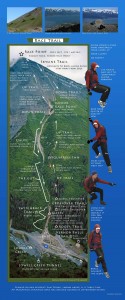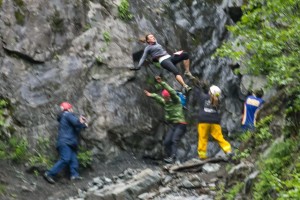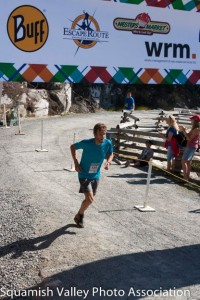
In 2013, the Mount Marathon garnered significant attention as the course record, set by Bill Spencer 32 years prior, was smashed by Alaska local Eric Strabel. Strabel, the head Nordic Ski Coach at APU, trained specifically for the race, both in terms of his fitness and sussing out the best possible course. Unique to the Mount Marathon are the course rules which essentially state that, aside from starting and finishing at the line, you must just run around the rock at the top of the course, choosing your own line as you go. With racers picking their own line through small cliff bands and down scree, this absolutely has an effect on the outcome of the race, especially on the descent.
Also of note in 2013 was the second place finisher, American ultra runner Rickey Gates. Gates actually led the race by a small margin until Strabel was able to overtake him on the descent (during which Gates fell and dislocated his shoulder see video linked at the bottom). Strabel out sprinted Gates who finished 2nd, also ahead of Spencer’s 1981 course record.
In 2014 both Gates and Strabel returned to the race for a rematch. Strabel again won with Gates finishing in 4th. As the notoriety of the race increases, bigger names will continue to show up and with the 2015 running, Seward will have the biggest name of all in attendance – Kilian Jornet! Jornet (ESP) is widely considered the best mountain runner in the world and is sure to do well at the Mount Marathon. Not only does he have one of the best engines in the world – routinely on top of skimo and sky running podiums – but also with a fantastic ability to run technical descents, a critical component of the Mount Marathon (See this shot of Jornet descending the Matterhorn – not 100% applicable but impressive nonetheless). The big question is: can Jornet knock Strabel off the top of the podium and set a new record time?
First looking at the uphill. The ascent requires approximately 33 minutes for the 880 meters of elevation gain. This is comparable time-wise to a vertical kilometre but is obviously less gain. It also includes a section of flat road at the beginning (for a total distance of 2.49 kilometres). The approximate grade of the climbing portion of the race is a fairly steep 35%! I’ll compare this to the vertical kilometre course in Chamonix which has an average grade of 26% for 1000 meters of gain. An interesting side note: the VK world record set in Fully, Switzerland by Urban Zemmer, is an amazing 1960 VAM! Fully is considered to be the most ideal VK course in the world with a direct ascent at a steady (and ideal) grade. VK racers also frequently use poles to ascend even faster.
Strabel’s fastest Mount Marathon ascent was 33.7 minutes. Because times between events like this are difficult to compare, it is easier to use a metric borrowed from cycling called VAM which is an estimation of ascent speed. Note the units are not m/sec but and arbitrary unit (VAM). Strabel’s ascent was at a mean VAM of 1567. Compare this to Jornet’s time of 34.9 minutes on the Chamonix VK climbing at a mean VAM of 1720. Significantly faster and with 120 additional meters of elevation gain. One thing to consider however is that the footing of most VK races (including in Chamonix) is significantly better than that of the Mount Marathon. Ascending well defined and groomed footpaths is much easier than loose scree. This certainly accounts for some loss in climbing speed.
Given Jornet’s fitness and the fact that he is regularly competing with and winning against the best athletes in the world, I would be hard pressed to bet against him being easily able to ascend the peak faster than anyone else. That being said, he may opt to race alongside the local athletes in order to follow their best line of descent back to the base and drop them once past any major technical difficulties. With such a short race however, (Strabel’s record descent is just over 11 minutes!) any small mistake could cause this strategy to backfire. A trip or fall like Ricky Gates’ in 2013 could jeopardize the race.

Besides SkinTrack’s general interest in mountain athletics, we are personally invested in this years Mount Marathon because one of the contenders is Squamish local and leader of the 2014-15 Canadian Ski Mountaineering National Team, Nick Elson! Nick applied for and was granted special permission to enter this year’s race and will be traveling to Seward shortly to start familiarizing himself with the course.
After chasing Jornet throughout the skimo season in Europe, Nick is familiar with his fitness and likely realizes that Jornet on top form will be unbeatable on the ascent. The top Alaskans however are certainly in Nick’s sights. If we look at the 2013 Grouse Grind race in which Nick placed third, the course tackles 853 meters of elevation with an average grade of 28% which is much closer to the Mount Marathon (by the numbers, the trace itself however is still very well defined- mostly stairs). Nick ran a mean VAM of 1786 – higher than Strabel’s 1567 VAM on Mount Marathon. We must also take into account the flat at the start of the Mount Marathon which reduces the VAM.
It is hard to compare performances on the descent as much of the Mount Marathon course features scree that can be almost skied down. Strabel’s amazing 11.01 minute descent has a VAM of -4795! Nick is well known as one of the strongest descenders in Canada and it will be interesting to see how he stacks up on the scree. In my opinion, Nick certainly has the potential to perform as one of the top three North Americans in the race. We caught up with Nick in the week leading up to the race.

Nick: I’ve been trying to train as much as possible on the steepest trails around Squamish. To prepare for the climb, I’ve been doing some hard workouts on terrain where I’m forced to power-hike. For the descent, I’ve been doing some faster downhill running although I always try to stay in control enough that I don’t fall and hurt myself and also don’t get so sore that I can’t train the next day.
Skintrack: The descent is pretty daunting. Have you been training specifically for that and do you have any strategies?
Nick: I think that the descent is a big part of what makes the race so exciting. The upper portion is on loose scree which appears to allow you to reach pretty high speeds.
Lower down it gets more technical and there are a few options including “the cliffs” and “the falls”.
The fact that there are no course markings and you can choose your own route definitely adds an interesting tactical element to the race (and explains how a runner disappeared and was never found during the 2012 race). I’ll have three days prior to the race to preview the course and hopefully find the best route for me personally. I’m definitely a bit nervous because I know that to be competitive in such a strong field I’m going to have to take some chances on the descent.
Skintrack: What are you looking forward to most about the race and finally what plans do you have for racing the rest of the summer?
Nick: I’m looking forward to the whole scene surrounding the race. This will be my fifth time in Alaska so I think I have an idea of what to expect. However, I think the whole experience will be a little bit crazy. After the Mt. Marathon race, I plan on running the NACAC/Canadian Mountain Running Championships at Cypress on July 18th. Then I’ll try to shift my focus to longer distances in the lead-up to the Squamish 50.
Not to leave out the women, recent years have not seen heavy competition. The female course record was set in 1990 by Nancy Pease in a time of 50.5 minutes (which would have earned her 11th place in the 2014 mens race) and stands fairly uncontested. Olympian Holly Brooks gave several serious stabs at the record but struggled with difficulties in the heat. Something that could be a major factor in this year’s race. 2015 is likely to be dominated by sky and ultra running superstar Emelie Forsberg. Forsberg (SWE) is attending the race for the first time but routinely dominates anything she enters. My bets are hands down on Emelie for the win.
Follow the race live here!
Mt Marathon:
880m Ascent
35% Grade
33.68 min (Eric Strabel) 1567 VAM
Downhill: 11.01 min
Overal Record: 42.92
Female – Nancy Pease (1990) 50.5 min (11th place in 2014 Men’s Race)
Chamonix VK:
1000m
26%
34.88 min (Killian Jornet) 1720 VAM
VK RECORD:
Fully Switzerland
1000m
30.6 min (Urban Zemmer) 1960 VAM
Grouse Grind:
853m
28%
26.38 min (Joe Grey) 1940 VAM
28.6 min (Nick Elson) 1786 VAM
Calculations:
VAM = (vertical ascent in meters X 60) / minutes


Leave a Reply